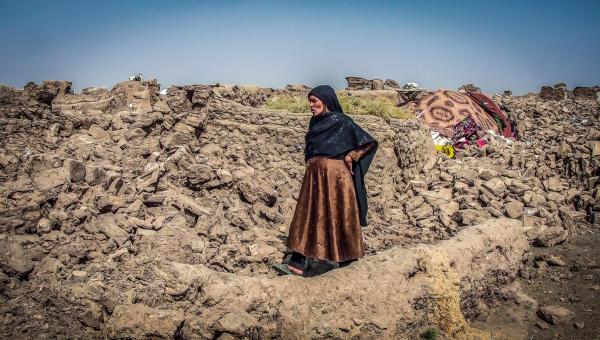A year after the earthquake in Haiti, local communities are building resilience
August 16, 2022

To support local economic recovery, UNDP created employment opportunities for people affected by the earthquake. The ‘Yes! She Paints’ initiative works with 60 women with an aim to reduce the deficit of female workers with trade skills in Haiti.
By the Resilience Unit team, UNDP Haiti
On Saturday, 14 August 2021, a 7.2-magnitude earthquake struck the southern peninsula of Haiti at approximately 8:30 a.m. local time, resulting in over 2,000 deaths, thousands of injuries and significant damage from collapsed buildings and blocked roads. It was a disaster reminiscent of the impact of the January 2010 earthquake, which was followed by Tropical Depression Grace.
Haiti has capitalized on the lessons learned in 2010. In 2021, the Government was better prepared. The day of the earthquake, through the National Risk and Disaster Management System, the Government activated the National and Departmental Emergency Operations Centres. Within minutes of the quake, UNDP was working alongside the Haitian Government at the national and departmental levels—in Sud, Nippes and Grand’Anse—setting into motion the post-earthquake response plan.
Underestimated but essential: Logistics
Unfortunately, for at least two years, the Southern Region, or ‘Grand Sud’, has experienced periods of isolation from the rest of the country owing to insecurity and fuel crises—a dynamic that tends to make this part of the country even more vulnerable. During the delivery of goods or humanitarian aid, attacks have been carried out and vehicles have been looted in the region and along Route Nationale 2. This impacts the supply chain for companies and humanitarian actors, but most significantly, the local population suffers the detrimental effects. In addition, all intermunicipal roads are in a precarious state. These are two major challenges for post-earthquake recovery.
On 14 August 2021, we therefore asked ourselves: how do we meet the needs of the people affected by the disaster and by the violence of armed groups? They were particularly vulnerable, and we could not leave them behind.
Fortunately, a truce was negotiated with the armed groups and communities along the route to Grand Sud, allowing a temporary humanitarian corridor to be established. This agreement made it possible for UNDP to send staff to the affected areas by providing logistical support, including personnel, vehicles, fuel and security.
Supporting rescue operations and risk assessment
On the ground, local UNDP teams witnessed a spirit of community solidarity. Having learned from other disasters, people were able to respond more quickly and effectively. For example, we witnessed the generosity of a group of anonymous citizens who travelled by sailboat to a hard-to-reach area to bring residents fruit, and even trees.
Moved by this spirit of collaboration, we joined in rescue operations coordinated by our partners on the ground, including the Civil Protection Directorate of Haiti. The UNDP post-earthquake programme response began in the three affected departments, in concert with municipal institutions. We carried out activities related to coordination, economic recovery and risk assessment.
One of the main problems in the affected areas was the accumulation of debris in the streets. To address it, we worked with town halls to organize debris collection. In the commune of Maniche, we assisted teams of volunteers who even used recovered debris to pave a road.
Building earthquake resilience through local action
Bearing in mind the need to keep communities informed and engaged, we organized informational and risk prevention sessions in local communities and schools. However, this course of action was severely hampered by widespread fuel shortages.
The team saw the need to contribute to local economic recovery by creating jobs for those most severely impacted by the earthquake. As a result, we started a ‘cash for work’ initiative that hired over 1,000 people on a temporary basis (at least 24 days) to clear debris and clean up towns. Financial support provided to 60 companies (20 per affected department) involved in agriculture and food production, handicrafts, sewing and other services aims to help local microenterprises to flourish.
Our commitment to the most vulnerable populations required us to focus on these locations over the long term. A critical component is empowering women, who often lose their jobs in the aftermath of earthquakes and are responsible for most household duties. In May 2022, we launched the initiative ‘Yes! She Paints’, working with 60 women with an aim to reduce the deficit of female workers with trade skills in Haiti. This included training in job readiness, painting buildings and ecological principles, for which there will be a follow-up to guarantee the continuity of these entrepreneurial activities.
Local institutions have taken note of our engagement with local populations. Despite our limited resources, they expressed appreciation for our efforts after several months. The mayors noted, “You did not hesitate. You were there from the beginning.”
Disaster responses are always complex and require efforts to be sustained for years, particularly in a developing country like Haiti, with a weak economic structure and plagued by social issues such as insecurity. Nevertheless, resilience does not necessarily mean being unshakeable, but rather shortening the time a country needs to recover from an adverse event. In this sense, the efforts to coordinate and strengthen the mobilization of citizens observed this past year represent progress compared to previous crises. It’s an important step forward for Haiti and its people, one that they will surely build on in the years to come.

 Locations
Locations




